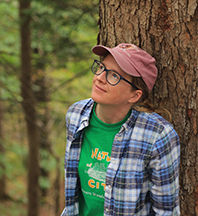Week of September 25, 2023 – September 30, 2023

by Anna Stunkel, Environmental Educator
As summer turns to fall, a rich palette of colors in nature is changing. This is most apparent in open spaces where goldenrods, asters, and other fall blooms paint the fields with a patchwork of colors such as yellow, purple, and white. In the big field adjacent to the Harrison Trail, native plants are emerging in full force. Among the blossoms, Candy-striped Leafhoppers bounce around and Red-legged Grasshoppers leap from plant to plant.
In the forest, leaves are just beginning to change color here and there. Lately I’ve been coming across Red Maple leaves on the ground that are partially green with patches of fall colors like red and yellow. I love this time of year, when some days are just cool enough to wear a light sweatshirt and there is a hint of fall leaf scent in the woods.
I’ve also enjoyed thinking back to summer memories experienced during camp and along my own nature explorations. One memory stands out in particular, in which a preschooler found an enormous Long-tailed Giant Ichneumonid Wasp laying eggs on one of the logs of our fort. These wasps use their very long ovipositors to drill into wood, paralyze the larva of a horntail wasp, and lay their eggs on the larva. The wasp’s own larvae then consume their host and grow into adults the following year. Despite an appearance that may seem scary to humans, this wasp species is harmless and can’t sting. Looking closely at the wasp’s patterns, I was amazed by the rich reddish brown, yellow, and black stripy coloring.
Thanks to the rain that we’ve been having, mushrooms and puffballs are also popping up among the leaf litter and fallen logs. These fungi come in many shapes, sizes, and colors, from cadmium orange to earthy camouflaged tones. A few weeks ago towards the end of camp, we discovered a small garden of earthstar fungi along the Field to Forest Trail. These small stars were an exciting find, especially since the campers enjoyed squeezing the puffballs so that their spores spread into the air. Each star was like a small throne with a little puffball sitting atop it.
As the days and nights gradually become cooler and the leaves brighten, see what kinds of changes you notice in the colors and patterns of nature around you. On rainy days, are the green hues of mosses and lichens more vibrant? Can you find a field of asters and take a moment to marvel at the colorful blossoms and the insects among them?

